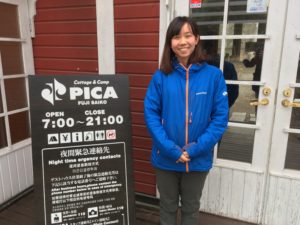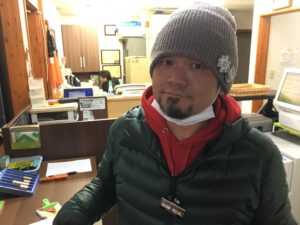I found myself more conflicted in many ways during this part of the trip than at any other time. I had hoped to hike Mt. Fuji, but the time of year made it impossible.
I also found myself entering a more contemplative mood. For my first two days at Lake Kawaguchiko, I didn’t really talk with anyone. I hiked up Mt. Tenjo-yama, I walked the entire perimeter of the lake, and I even started hiking towards Lake Saiko on the second day.
It was when I reached the Lake Saiko area that I knew that I would have to stay one more night. The area around Lake Kawaguchiko is much more developed. The main train and bus station is there. There are a number of big hotels and restaurants.
At Lake Saiko, I found something that I had been longing to find–a place to camp. In fact, there are a number of places to camp around the smaller, but more serene lake.
PICA Campground offers a whole range of options for would-be campers. You can use a tent like I did, or you could rent out one of their trailers or Mongolian yurts. You can rent bicycles or canoes or purchase fishing and camping gear from their store. They even sell firewood and marshmallows (I did and it took me back to when my wife and I used to take McKenzie camping when she was little and we would make ‘smores).

Momoko helped me find a good spot to camp near Lake Saiko. She’s just one of the many friendly staff members at PICA.
It was at PICA that I met Momoko, a pleasant young woman who has been working there for five years.
“A lot of families and friends come here to stay. The lake itself is beautiful, and there are a lot of animals.”
She told me that summer is the busy season, but PICA was by no means abandoned. I saw some fellow campers, although most were using much larger tents with heating units.
“Each summer about 240,000 people come to hike Mt. Fuji,” said Momoko. She’s hiked it herself 14 times.
She told me that I should definitely come back and hike it during the summer.
After pitching my tent, I set out to explore the surrounding area.
If you use the green line bus service (you can buy a two day pass for very little money), you can travel to the various caves that formed due to the volcanic activity in the area. While the bat cave was closed, the wind and ice cave were open. It had been a long time since I had entered a cave, and I found both to be quite beautiful.

Kazuhiro not only told me about Aokigahara. He provided me with a helmet to protect me when I entered the ice cave (it gets pretty tight in there) and let me leave my daypack in his office while I was having my subterranean experience.
But the real secret of the area that won’t cost you a dime is the Aokigahara forest. The word means “A sea of trees,” and it is an apt description. The forest is as dangerous as it is beautiful because of volcanic formations within it. There are deep fissures hidden amongst the fungi-covered trees where you could twist an ankle or even fall into completely.
I learned this from Kazuhiro, one of the rangers who works at Narusawa, the ice cave. I was trying to get to a more southern section of the forest and had asked he and one of his colleagues for advice. He explained that the forest was all around me, but that it was very important that I stay on the paths. He gave me a map with a clearer indication of those paths too.
The woods reminded me of the area where I camped on the Isle of Skye in Scotland, except the trees were more contorted. When I started my walk, the clouds were still thick, and there was a dark haze over the twisted trees, the green undergrowth, and the black fissures.
I could see why some have grown to associate the place with despair, but, as I walked and looked more closely, I could see real beauty in the details of the tapestry of light and shadow.
As if in response to my appreciation, the clouds dissipated and the evening sun sprinkled red and gold into the palette of the forest, and I found the solitude of my last night beneath Fuji to be restorative.
Until my next post, keep looking to the heavens and seeking your own star.

amazing photographs. The ice cave was the best..